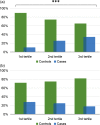Antioxidant and inflammatory potential of diet among women at risk of cervical cancer: findings from a cross-sectional study in Italy
- PMID: 33958013
- PMCID: PMC9991670
- DOI: 10.1017/S1368980021001944
Antioxidant and inflammatory potential of diet among women at risk of cervical cancer: findings from a cross-sectional study in Italy
Abstract
Objective: To evaluate the association of Composite Dietary Antioxidant Index (CDAI) and Dietary Inflammatory Index (DII) with the prevalence of high-grade cervical intraepithelial neoplasia (CIN).
Design: A cross-sectional study was conducted on women with abnormal Papanicolaou test, who underwent high-risk human papillomavirus (HPV) screening and histological test through colposcopy. Dietary data were collected using a FFQ and used to assess both CDAI and DII.
Setting: Women were recruited from 2012 to 2015 at the Cervical Cancer Screening Unit of the 'Azienda Sanitaria Provinciale' of Catania (Italy).
Participants: The study included 539 women with a mean age of 40·2 years, who were classified as cases (n 127 with CIN2 or more severe lesions) and controls (n 412 with normal cervical epithelium or CIN1).
Results: Although we observed a lower proportion of HPV-positive women among those with higher CDAI (P < 0·001), the index was not associated with the diagnosis of CIN2 or more severe lesions. By contrast, women with medium or high DII showed higher odds to be diagnosed with CIN2 or more severe lesions than those with low DII (OR = 2·15; 95 % CI 1·11, 4·17; P = 0·024 and OR = 3·14; 95 % CI 1·50, 6·56; P = 0·002, respectively), after adjusting for age, HPV status, educational level, BMI, smoking status, parity, use of oral contraceptives and supplements.
Conclusions: Our findings suggested that a pro-inflammatory diet might be associated with an increased risk of CIN2 and more severe lesions. However, further prospective studies should be encouraged to support this evidence.
Keywords: Diet; HPV infection; Inflammation; Nutritional epidemiology; Oxidative stress.
Figures



Similar articles
-
Dietary Antioxidant Intake and Human Papillomavirus Infection: Evidence from a Cross-Sectional Study in Italy.Nutrients. 2020 May 12;12(5):1384. doi: 10.3390/nu12051384. Nutrients. 2020. PMID: 32408636 Free PMC article.
-
Human papillomavirus test with cytology triage in organized screening for cervical cancer.Acta Obstet Gynecol Scand. 2016 Nov;95(11):1220-1227. doi: 10.1111/aogs.13013. Acta Obstet Gynecol Scand. 2016. PMID: 27591407
-
The impact of age and high-risk human papillomavirus (hrHPV) status on the prevalence of high-grade cervical intraepithelial neoplasia (CIN2+) in women with persistent hrHPV-positive, cytology-negative screening samples: a prospective cohort study.BJOG. 2020 Sep;127(10):1260-1267. doi: 10.1111/1471-0528.16250. Epub 2020 May 3. BJOG. 2020. PMID: 32279427
-
[Real-world research on cervical cancer screening program and effect evaluation for Chinese population].Zhonghua Zhong Liu Za Zhi. 2018 Oct 23;40(10):764-771. doi: 10.3760/cma.j.issn.0253-3766.2018.10.008. Zhonghua Zhong Liu Za Zhi. 2018. PMID: 30392341 Chinese.
-
Long-term observational approach in women with histological diagnosis of cervical low-grade squamous intraepithelial lesion: an Italian multicentric retrospective cohort study.BMJ Open. 2019 Jul 3;9(7):e024920. doi: 10.1136/bmjopen-2018-024920. BMJ Open. 2019. PMID: 31272971 Free PMC article.
Cited by
-
Drugs and drug targets for the treatment of HPV-positive cervical cancer.Tumour Virus Res. 2025 Jun;19:200309. doi: 10.1016/j.tvr.2024.200309. Epub 2024 Dec 19. Tumour Virus Res. 2025. PMID: 39709045 Free PMC article. Review.
-
Nature of the Association between Rheumatoid Arthritis and Cervical Cancer and Its Potential Therapeutic Implications.Nutrients. 2024 Aug 5;16(15):2569. doi: 10.3390/nu16152569. Nutrients. 2024. PMID: 39125448 Free PMC article. Review.
-
How COVID-19 Pandemic Has Influenced Public Interest in Foods: A Google Trends Analysis of Italian Data.Int J Environ Res Public Health. 2023 Jan 20;20(3):1976. doi: 10.3390/ijerph20031976. Int J Environ Res Public Health. 2023. PMID: 36767342 Free PMC article.
-
Association between the composite dietary antioxidant index and non-alcoholic fatty liver disease: evidence from National Health and Nutrition Examination Survey 2005-2016.Front Nutr. 2025 Jan 23;12:1473487. doi: 10.3389/fnut.2025.1473487. eCollection 2025. Front Nutr. 2025. PMID: 39917746 Free PMC article.
-
Associations between composite dietary antioxidant index and estimated 10-year atherosclerotic cardiovascular disease risk among U.S. adults.Front Nutr. 2023 Aug 10;10:1214875. doi: 10.3389/fnut.2023.1214875. eCollection 2023. Front Nutr. 2023. PMID: 37637947 Free PMC article.
References
-
- Bray F, Ferlay J, Soerjomataram I et al. (2018) Global cancer statistics 2018: GLOBOCAN estimates of incidence and mortality worldwide for 36 cancers in 185 countries. CA Cancer J Clin 68, 394–424. - PubMed
-
- Louie KS, Castellsague X, de Sanjose S et al. (2011) Smoking and passive smoking in cervical cancer risk: pooled analysis of couples from the IARC multicentric case-control studies. Cancer Epidemiol Biomarkers Prev 20, 1379–1390. - PubMed
-
- Zur Hausen H (2002) Papillomaviruses and cancer: from basic studies to clinical application. Nat Rev Cancer 2, 342–350. - PubMed
MeSH terms
Substances
LinkOut - more resources
Full Text Sources
Other Literature Sources
Medical

